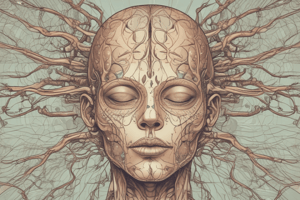Podcast
Questions and Answers
Qual es un nerve que originate del ramo posterior?
Qual es un nerve que originate del ramo posterior?
- Nervio torácico largo
- Nervio dorsal de la escápula (correct)
- Nervio cutáneo braquial medial
- Nervio pectoral medial
Quante divisiones anteriores existe in total?
Quante divisiones anteriores existe in total?
- 2 divisiones
- 3 divisiones (correct)
- 4 divisiones
- 5 divisiones
Qual es un de los 5 ramos terminales?
Qual es un de los 5 ramos terminales?
- Nervio radial
- Nervio femoral
- Nervio subescapular inferior (correct)
- Nervio olecrano
Qual nerve es parte del nervios cranial?
Qual nerve es parte del nervios cranial?
Qual nerve pertence al sistema visual?
Qual nerve pertence al sistema visual?
Qual nerveo es associate con le bulbo olfatorio?
Qual nerveo es associate con le bulbo olfatorio?
Qual parte del encéfalo es responsable del coordinamento motor?
Qual parte del encéfalo es responsable del coordinamento motor?
Qual nervio controla le movimento del pupilla?
Qual nervio controla le movimento del pupilla?
Le cual nervio es implicate in le senso del taste?
Le cual nervio es implicate in le senso del taste?
Qual structure es situada inter le hemispherios cerebrales?
Qual structure es situada inter le hemispherios cerebrales?
Qual nerveo es associate con le movimento del músculo recto inferior?
Qual nerveo es associate con le movimento del músculo recto inferior?
Qual parte del sistema nervioso regule le activitate automatica del corpore?
Qual parte del sistema nervioso regule le activitate automatica del corpore?
Qual nervio es implicate in le sensation de dolore in le braccio?
Qual nervio es implicate in le sensation de dolore in le braccio?
Flashcards
Nervio dorsal de la escápula
Nervio dorsal de la escápula
Un nervio que inerva el músculo elevador de la escápula y el músculo romboides.
Nervio torácico largo
Nervio torácico largo
Un nervio que inerva el músculo serrato anterior, el cual ayuda a rotar y estabilizar la escápula.
Nervio pectoral medial
Nervio pectoral medial
Un nervio que inerva los músculos pectorales mayor y menor, que ayudan a la flexión, aducción y rotación medial del brazo.
Nervio subescapular superior
Nervio subescapular superior
Signup and view all the flashcards
Nervio toracodorsal
Nervio toracodorsal
Signup and view all the flashcards
Bulbo olfatorio
Bulbo olfatorio
Signup and view all the flashcards
Nervo óptico
Nervo óptico
Signup and view all the flashcards
Cerebelo
Cerebelo
Signup and view all the flashcards
Bulbo raquídeo
Bulbo raquídeo
Signup and view all the flashcards
Tálamo
Tálamo
Signup and view all the flashcards
Hipotálamo
Hipotálamo
Signup and view all the flashcards
Quiasma optic
Quiasma optic
Signup and view all the flashcards
Piamadre
Piamadre
Signup and view all the flashcards
Study Notes
Cranial Nerves
- Cranial nerves are part of the peripheral nervous system, connected to the brain stem.
- There are twelve pairs.
- Each nerve has a specific function, such as sensory, motor, or both.
- Olfactory (I) - Sensory nerve, responsible for smell
- Optic (II) - Sends visual impulses to the brain.
- Oculomotor (III) - Controls most eye muscles.
- Trochlear (IV) - Controls superior oblique muscle of the eye.
- Trigeminal (V) - Sensory nerve for facial sensation, and motor nerve controlling chewing muscles.
- Abducens (VI) - Controls the lateral rectus eye muscle.
- Facial (VII) - Sensory: taste; Motor: controls facial expressions.
- Vestibulocochlear (VIII) - Sensory for hearing and balance.
- Glossopharyngeal (IX) - Sensory: taste; Motor: swallowing
- Vagus (X) - Sensory: sensations from internal organs; Motor: heart, lungs, and digestive organs (controls their function).
- Accessory (XI) - Motor: controls muscles in neck and shoulders.
- Hypoglossal (XII) - Motor: controls tongue movements.
Eye Muscles
- Rectus Superior
- Rectus Lateral
- Rectus Inferior
Spinal Cord Anatomy
- Spinal nerves are part of the peripheral nervous system; they branch to innervate the body.
- Ventral roots carry motor information away from the spinal cord.
- Dorsal roots carry sensory information to the spinal cord.
- Spinal cord is surrounded by three layers of protective membranes (meninges).
- Dura mater is the outermost, tough layer.
- Arachnoid mater is the middle, thin layer.
- Pia mater is the innermost, delicate layer.
- Gray matter is dominated by nerve cell bodies and dendrites.
- White matter contains nerve fibers.
- There are different regions within the spinal cord: ventral horn, dorsal horn etc.
Nervous System Branches
- Branches of the nerves stemming from the brachial plexus are crucial for upper limb function.
- Different nerve bundles control various aspects of the limbs (different muscles).
- These branches include:
- Axillary
- Musculocutaneous
- Median
- Radial
- Ulnar
Cranial Bones and Eye Anatomy
- Bones like the frontal and zygomatic contribute to the eye's structure.
- Eye features such as the iris and pupil are visible.
- Lacrimal bone and frontal bone are also part of the eye socket.
Brain Anatomy
- Brain structures include parts like the:
- Cerebellum (coordinates movement)
- Brainstem (controls involuntary functions)
- Cerebrum (higher brain function)
- Different lobes, sulci, and gyri.
- Gray and white matter in various brain regions.
- Structures like corpus callosum, thalamus, and hypothalamus.
- Ventricles and other internal spaces are also present in the brain.
Studying That Suits You
Use AI to generate personalized quizzes and flashcards to suit your learning preferences.



